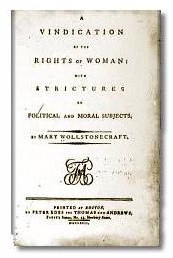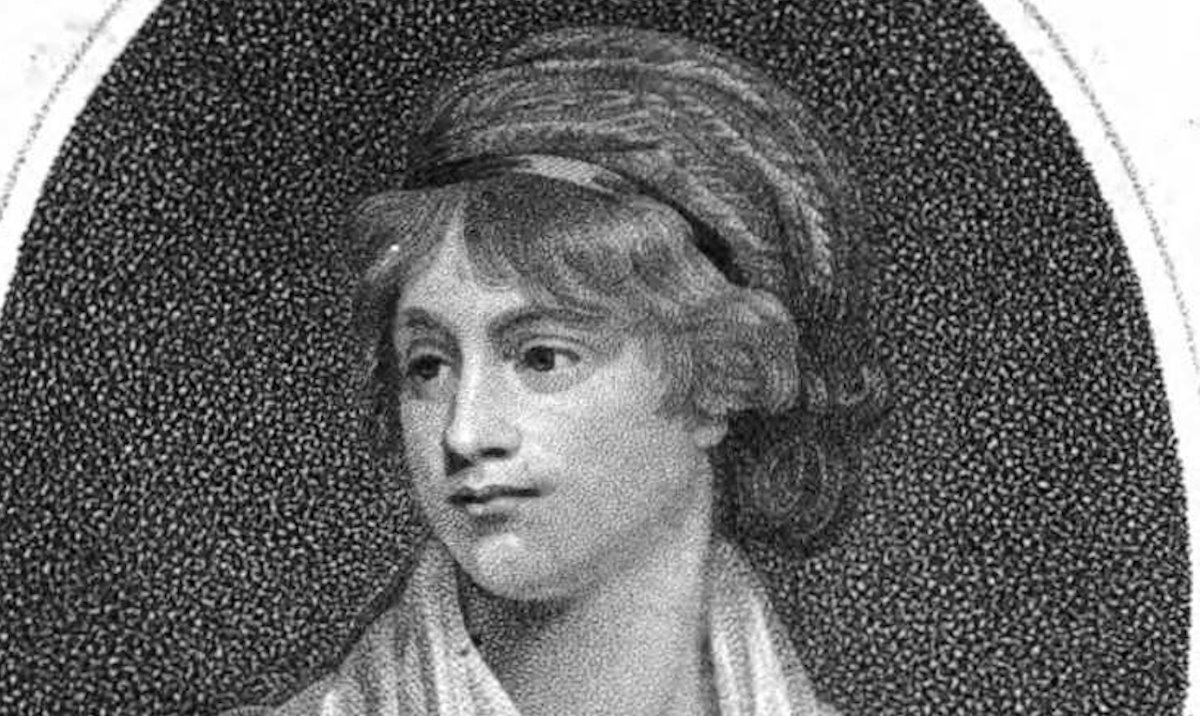Mary Wollstonecraft has long been appreciated as a major political thinker – but she also made important contributions to educational theory and practice. Barry Burke investigates.
contents: introduction · Mary Wollstonecraft on education · conclusion · bibliography · how to cite this article. See, also in the archives Mary Wollstonecraft on national education from A Vindication of the Rights of Women.
Mary Wollstonecraft (1759-97) was born in Spitalfields in 1759. Her father uprooted the family on a number of occasions and during her formative years Mary Wollstonecraft was to find herself in Epping, Barking, Beverley in Yorkshire, back to East London in Hoxton and then out again to Wales. At the age of 18, having received a poor education, she left home and never went back.
She became a companion to a widow in Bath for a short period, then moved back to London (first to Fulham and then to Hackney). In 1784, at the age of 24 Mary Wollstonecraft opened up her own school for girls at Newington Green. This did not last long and she finally became a governess to the children of an aristocratic family on their estate in Ireland. This, in turn, was another short appointment and in 1787, Mary Wollstonecraft finally came back to London and settled in George Street just south of Blackfriars Bridge.
Five minutes walk away was St. Pauls’ Churchyard which, at the time, was the centre of the publishing trade. Mary Wollstonecraft was given work by Joseph Johnson, a radical and progressive publisher and spent most of her waking hours in his shop, writing and translating, as well as eating her meals and meeting a whole range of radical intellectuals and progressive thinkers. Gradually, Mary became part of a circle of friends who were constantly discussing the political affairs of the day.
In 1786, Mary Wollstonecraft wrote a short tract entitled Thoughts on the Education of Daughters but it was the advent of the French Revolution in 1789 that brought Mary into the public eye. As is well known, the Revolution was welcomed by many radicals throughout Europe. The new Republic’s principles of liberty, equality and fraternity were seen as opening a new chapter in the struggle against aristocracy and for a democratic society. Reaction in this country from the wealthy aristocracy and their followers was vitriolic. Supporters of the Revolution were viewed as dangerous subversives and were attacked at every opportunity.
The first major critique was Edmund Burke’s Reflections on the Revolution in France which both attacked the Revolution and its supporters in this country. On reading it, Mary Wollstonecraft decided to respond writing A Vindication of the Rights of Man – a defence of the Revolution and its principles. The book, published in 1790, was not particularly well written although it became very popular and made her name known. Soon after Mary Wollstonecraft’s book came out, Tom Paine wrote his classic The Rights of Man. In 1792, Mary Wollstonecraft produced A Vindication of the Rights of Woman. It was a significant milestone in the arguments around women’s rights and has since become a feminist classic. It was translated into French almost immediately and brought Mary Wollstonecraft fame not only in this country but also on the continent and in the United States.
Mary Wollstonecraft was not, however, to build on her fame or to write anything else of note. Five years after the book was published and shortly after her marriage to William Godwin, Mary died giving birth to a baby daughter – Mary. As is well known, Mary Wollstonecraft Godwin was later to marry the poet Shelley and as Mary Shelley, became famous as the author of the great gothic novel Frankenstein.
Mary Wollstonecraft on education
So why should Mary Wollstonecraft be of any great importance as an educational thinker?
A Vindication of the Rights of Woman is more often than not regarded as a purely political treatise. However, like Plato’s Republic and Rousseau’s Emile, it can be seen as both a political and an educational treatise.
It is above all a celebration of the rationality of women. It constitutes an attack on the view of female education put forward by Rousseau and countless others who regarded women as weak and artificial and not capable of reasoning effectively. Mary Wollstonecraft rejected the education in dependency that Rousseau advocated for them in Emile. A woman must be intelligent in her own right, she argued. She cannot assume that her husband will be intelligent! Mary Wollstonecraft maintained that this did not contradict the role of the woman as a mother or a carer or of the role of the woman in the home. She maintained that ‘meek wives are, in general, foolish mothers’.
Reason was her starting point. For Mary Wollstonecraft, rationality or reason formed the basis of our human rights as it was our ability to grasp truth and therefore acquire knowledge of right and wrong that separated us, as human beings, from the animal world. Through the exercise of reason we became moral and political agents. This world-view was acknowledged by all progressive thinkers of the time. However, it was essentially a man’s world and the work of Rousseau was typical of this. What Mary Wollstonecraft did was extend the basic ideas of Enlightenment philosophy to women and Rousseau’s educational ideas of how to educate boys to girls.
She set about arguing against the assumption that women were not rational creatures and were simply slaves to their passions. Mary Wollstonecraft argued that it was up to those who thought like this to prove it. She described the process by which parents brought their daughters up to be docile and domesticated. She maintained that if girls were encouraged from an early age to develop their minds, it would be seen that they were rational creatures and there was no reason whatsoever for them not to be given the same opportunities as boys with regard to education and training. Women could enter the professions and have careers just the same as men.
In proposing the same type of education for girls as that proposed for boys, Mary Wollstonecraft also went a step further and proposed that they be educated together which was even more radical than anything proposed before. The idea of co-educational schooling was simply regarded as nonsense by many educational thinkers of the time.
It was fashionable to contend that if women were educated and not docile creatures, they would lose any power they had over their husbands. Mary Wollstonecraft was furious about this and maintained that ‘This is the very point I aim at. I do not wish them to have power over men but over themselves’.
The most perfect education, in my opinion, is such an exercise of the understanding as is best calculated to strengthen the body and form the heart. Or, in other words, to enable the individual to attain such habits of virtue as will render it independent. In fact, it is a farce to call any being virtuous whose virtues do not result from the exercise of its own reason. This was Rousseau’s opinion respecting men: I extend it to women.
Mary Wollstonecraft – A Vindication of the Rights of Woman
Mary Wollstonecraft favoured co-educational day schools, lessons given by informal conversational methods, with lots of physical exercise both free and organised. She had a picture of an ideal family where the babies were nourished by an intelligent mother and not sent away to nurses and then to boarding school and fathers were friends to their children rather than tyrants. Essentially family members were all regarded as rational beings and children should be able to judge their parents like anyone else. Family relationships therefore became educational ones.
Conclusion
A Vindication of the Rights of Woman covered a wide range of topics relating to the condition of women. Not only did she argue for women’s equality with men in education but she also called for their equality within the law as well as their right to parliamentary representation. As Jane Roland Martin has commented in the nineteenth and twentieth centuries reformers looked to coeducational schooling – and it became a ‘fact of life’ for many millions of people. The problem is that ‘this great historical development turned out to be a carrier of old inequities and the creator of new problems for women’ (2001: 71-2). Not only is it necessary to ensure that coeducation is ‘girl and women friendly’ it is also necessary to design education for both sexes that ‘incorporates the virtues of rationality and self-governance that Rousseau attributed to men and also the virtue of patience and gentleness, zeal and affection, tenderness and care that he attributed to women’ (op. cit.). Mary Wollstonecraft was a pioneer for women. She led the way for feminists and her book is a classic that still inspires many today.
Bibliography
Craciun, C. (2002) A Routledge Literary Sourcebook on Mary Wollstonecraft’s “A Vindication of the Rights of Woman”, London: Routledge
Falco, M. J. (ed.) (1996) Feminist Interpretations of Mary Wollstonecraft, Penn State University Press.
Jacobs, D. (2001). Her own woman: The life of Mary Wollstonecraft. New York: Simon & Schuster.

Gordon, L. (2005). Mary Wollstonecraft: A new genus. London: Little, Brown.
Johnson, C. L. (2002). The Cambridge companion to Mary Wollstonecraft. Cambridge companions to literature. Cambridge, UK: Cambridge University Press.
Martin, J. R. (2001) ‘Mary Wollstonecraft’ in J. A. Palmer (ed.) Fifty Major Thinkers on Education. From Confucius to Dewey, London: Routledge.
Miller, C. (1999) Mary Wollstonecraft and the Rights of Women, Morgan Reynolds.
Moore, J. (1999) Mary Wollstonecraft, Northcote House Educational Publishers.
Taylor, B. (2003) Mary Wollstonecraft and the Feminist Imagination, Cambridge: University of Cambridge Press.
Todd, J. (2000) Mary Wollstonecraft: A Revolutionary Life, London: Weidenfeld and Nicolson.
Tomalin, C. (1992) The Life and Death of Mary Wollstonecraft, London: Penguin Books.
Wollstonecraft, Mary (1993) Political Writings: A Vindication of the Rights of Men; A Vindication of the Rights of Woman; and An Historical and Moral View of the Origin and Progress of the French Revolution, ed. by Janet Todd, Toronto.
Wollstonecraft, Mary (1993) A Vindication of the Rights of Woman, London: Penguin. Full electronic text: http://oregonstate.edu/instruct/phl302/texts/wollstonecraft/woman-contents.html.
Wollstonecraft, Mary (1994) Maria or the Wrongs of Woman, New York: Norton.
Note: Chapter 12 ‘On National Education’ from A Vindication of the Rights of Woman is available in the informal education archives.
Acknowledgements: Picture: Mary Wollstonecraft – frontispiece of Memoirs of the author of A vindication of the rights of woman, William Godwin, 2d ed. 1798. James Heath (1757–1834), engraved from the painting of John Opie (1761–1807). Sourced from Wikimedia Commons. Believed to be in the public domain. The picture of the cover of ‘Vindication’ was sourced from Wikimedia Commons and is believed to be in the public domain.
How to cite this article: Burke, B. (2004) ‘Mary Wollstonecraft on education’, The encyclopedia of pedagogy and informal education. [ https://infed.org/mobi/mary-wollstonecraft-on-education/. Retrieved: insert date]
© Barry Burke 2004
